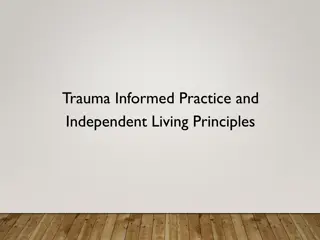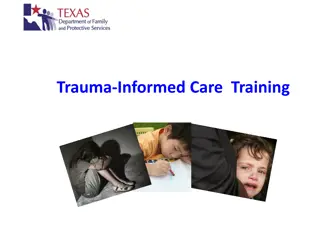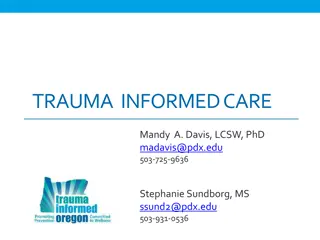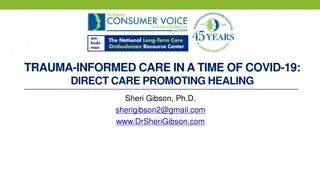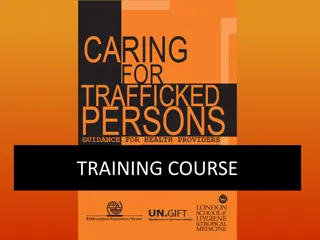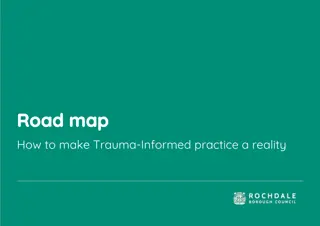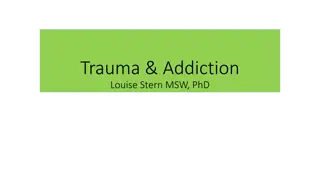Understanding Trauma-Informed Care in a Pandemic Era
Explore the complexities of trauma-informed care amidst the challenges of COVID-19, focusing on individual responses, elements of care, and the prevalence of trauma. Discover the impact of traumatic events, the power of empathy, and the key approaches to promoting healing in a shattered world.
Download Presentation

Please find below an Image/Link to download the presentation.
The content on the website is provided AS IS for your information and personal use only. It may not be sold, licensed, or shared on other websites without obtaining consent from the author. Download presentation by click this link. If you encounter any issues during the download, it is possible that the publisher has removed the file from their server.
E N D
Presentation Transcript
TRAUMA TRAUMA- -INFORMED CARE IN A TIME OF COVID INFORMED CARE IN A TIME OF COVID- -19: PROMOTING HEALING PROMOTING HEALING 19: Sheri Gibson, Ph.D. www.DrSheriGibson.com
Individual Responses are Multifaceted Pre-pandemic circumstances and resources Prior exposure to adversity Physical and mental health vulnerabilities Economic and social supports Exposures encountered since the pandemic: Illness of a family member Loss of job or health insurance Job status essential health care workers Time immersed in social media, news, over-exposure to information Community-level stressors e.g., Hot spots
Trauma-Informed Care SAMHSA s Trauma-Informed Approach: Behavioral Health is essential to health Prevention works Treatment is effective
Trauma Informed Care Elements Understanding the prevalence Recognizing how trauma impacts Putting this knowledge into practice to actively resist re actively resist re- -traumatization prevalence of trauma impacts individuals practice traumatization SAMHSA
Prevalence of Trauma: Approach Video: Power of Empathy
What is Trauma? Individual trauma results from an event, series of events, or set of circumstances experienced by an individual as physically or emotionally harmful or life threatening and that has lasting adverse effects on the individual s functioning and mental, physical, social, emotional, or spiritual well-being
Potential Traumatic Events Chronic Stressors Poverty Racism Invasive medical procedure Community trauma Historical trauma Family member with substance use disorder Abuse Emotional Sexual Physical Domestic violence Witnessing violence Bullying Cyberbullying Institutional Loss Death Abandonment Neglect Separation Natural disaster Accidents Terrorism War
Prevalence of Trauma Exposure to trauma is ubiquitous: seven out of ten respondents worldwide and nine out of ten adults in the USA report experiencing one or more lifetime traumas. Fink, Galea, 2015
Impact of Trauma on the Brain The brain has a bottom-up organization Experiences build brain architecture Fear activates the amygdala and shuts down the frontal lobes of the cortex. Toxic stress derails healthy development, and interferes with normal functioning Perry, 2006
Impact of Trauma: Adverse Childhood Experiences CDC
Impact of Trauma The effect of trauma on an individual can be conceptualized as a normal response to an abnormal situation
Impact of Trauma: Problems OR Adaptations? Non-compliant, combative OR Struggling to regain or hold onto personal power Fight Treatment resistant, uncooperative OR Disengaging, withdrawing Flight Passive, unmotivated OR Giving in to those in power Freeze
Impact of Trauma: Signs of Trauma Responses Flashbacks or frequent nightmares Sensitivity to noise or to being touched Always expecting something bad to happen Not remembering periods of one s life Feeling emotionally numb Lack of concentration Irritability Excessive watchfulness, anxiety, anger, shame or sadness Additional Signs
PRACTICE OF TRAUMA INFORMED CARE DURING COVID-19
Trauma Brain = Dysregulated Behavior As residents anxiety increases, their thinking brains become less engaged and behavior becomes more dysregulated. YOU can develop skills to help residents regulate and related by becoming calmer and more connected. This is achieved by: Warmth Validation Flexibility Structure Hope for the future Humor Being part of a connected community
Eleven things never to say to anyone 1. 2. 3. 4. 5. 6. 7. 8. 9. 10. I m doing this for your own good. 11. Why don t you be reasonable? Come here. You wouldn t understand. Because those are the rules. It s none of your business. What do you want me to do about it? Calm down. What s your problem? You never (or) you always. I m not going to say this again.
Statements: Reflection, Empathy, Validation Verbally reflect It sounds like you feel very angry about this. reflect another s emotional state: Offer the ultimate empathic Let me be sure what I heard is what you just said. empathic statement: Validate Validate the person s emotions: You had to wait three days for me to return your call, and your question was really important to you. I understand why you re made about this.
Be Concise When persons are agitated, their ability to process verbal information may be compromised; thus, use short sentences and simple vocabulary. Give the individual time to process what has been been said to him/her and to respond before providing additional information.
Repetition is essential Persistently repeat your message until it is heard. Repetition is essential whenever making request, setting limits, offering choices, or proposing alternatives. Combine this skill with assertiveness skills such as active listening and agreeing with the individual s position whenever possible.
Identify Wants and Feelings Whether or not a request by the individual can be fulfilled or granted, all persons need to be asked what their request is: I really need to know what you expected when you came here and, Even if I cannot provide it, I would like to know so we can work on it.
Use Active Listening Convey through verbal acknowledgement, conversation, and body language that you are really paying attention to the individual, and what they are saying and feeling. Use clarifying statements such as, Tell me if I have this right This does not mean you agree with the individual, but that you understanding what he/she is saying.
Agree or Agree to Disagree Find something about the person s position with which you can agree. Three ways to agree: Agree with the truth. ( Yes, it is warm in here; let me see if I can adjust the temperature ) Agree in principle. ( I believe everyone should be comfortable or free from discomfort. ) Agree with the odds. ( There are probably other people here who are also warm. ) Agree as much as possible it s important to acknowledge (in delusional situations) that you have never experienced what the person is experiencing but you believe they are having that experience. If you can t honestly agree, then agree to disagree.
Limit Setting: Done in a reasonable and respectful manner Setting limits demonstrates your intent and desire to help but not to be abused by the person. If the person is making you feel uncomfortable, this must be acknowledged. Often times, telling the person that his/her behavior is frightening or provocative is helpful if it is matched with an empathic statement that the desire to help can be interrupted or derailed if you feel angry or fearful.
Coach the Person in How to Stay in Control Use gentle confrontation with instruction: I really want you to sit down; when you pace, I feel frightened, and I can t pay full attention to what you are saying. I bet you could help me understand if you were to calmly tell me your concerns.
Offer Choices and Optimism Offer things that will be perceived as an act of kindness, such as a blanket, magazine, and access to a phone. Food and drink may be a choice the person is willing to accept that will stall aggressive behaviors. Be mindful that these choices must be realistic never deceive a person by promising something that cannot be provided.
Trauma Informed Care: Further Reading Judith Herman (2015) Trauma and Recovery Linda Sanford (1991) Strong at the Broken Places Robert Sapolsky (2004) Why Zebras Don t Get Ulcers Bessel Van Der Kolk (2014). The Body Keeps the Score
Trauma Informed Care: Bibliography Alameda County Behavioral Health Care Services. Trauma Informed Care. alamedacountytraumainformedcare.org Brown, D. W., Anda, R. F., Tiemeier, H., Felitti, V. J., Edwards, V. J., Croft, J. B., & Giles, W. H. (2009). Adverse childhood experiences and the risk of premature mortality. American Journal of Preventive Medicine, 37, 389 396. Centers for Disease Control and Prevention. About the CDC-Kaiser ACE Study. https://www.cdc.gov/violenceprevention/acestudy/about.html
Trauma Informed Care: Bibliography Felitti, Vincent J.; Anda, Robert F.; Nordenberg, Dale; Williamson, David; Spitz, Alison; Edwards, Valerie; Koss, Mary; and Marks, James. (1998) Relationship of Child Abuse and Household Dysfunction to Many of the Leading Causes of Death in Adults. American Journal of Preventive Medicine, 14:4, 245-258. Fink, David S., and Galea, Sandro. (2015). Life Course Epidemiology of Trauma and Related Psychopathology in Civilian Populations. Curr Psychiatry Rep, 17:31. Lieberman, Leslie. Walking the Walk: Modeling Trauma Informed Practice in the Training Environment. Multiplying Connections.
Trauma Informed Care: Bibliography Mueser, K.T., Salyers, M.P., Rosenberg, S.D., Goodman, L.A., Essock, S.M., et al. (2004). Interpersonal Trauma and Posttraumatic Stress Disorder in Patients With Severe Mental Illness: Demographic, Clinical, and Health Correlates. Schizophrenia Bulletin, 30 (1), 45-57 Read et al, 2008 National Center for PTSD. http://www.ptsd.va.gov/public/pages/ptsd_substance_abuse_veterans.asp Perry, B. D. (2006). Applying principles of neurodevelopment to clinical work with maltreated and traumatized children: The neurosequential model of therapeutics. In Boyd- Webb, N, ed. Working with traumatized youth in child welfare. New York: Guilford Press.
Trauma Informed Care: Bibliography Substance Abuse and Mental Health Services Administration, Center for Mental Health Services, National Center for Trauma Informed Care. SAMHSA s Trauma Informed Approach: Key Assumptions and Principles Curriculum. Substance Abuse and Mental Health Services Administration. SAMHSA s Concept of Trauma and Guidance for a Trauma Informed Approach. HHS Publication No. (SMA) 14-4884. Rockville, MD: Substance Abuse and Mental Health Services Administration, 2014. SAMHSA (2011). Current Statistics on the Prevalence and Characteristics of People Experiencing Homelessness in the United States. http://homeless.samhsa.gov/ResourceFiles/hrc_factsheet.pdf SAMHSA (2009) Substance Abuse Treatment: Addressing the Specific Needs of Women. Treatment Improvement Protocol (TIP) Series, No. 51. Center for Substance Abuse Treatment. Rockville (MD): Substance Abuse and Mental Health Services Administration.
Trauma Informed Care: Bibliography Wisconsin Department of Health Services. Trauma Informed Care Skill Development. Wisconsin Department of Health Services, Division of Mental Health and Substance Abuse Services. https://www.dhs.wisconsin.gov/tic/skilldev.pdf





